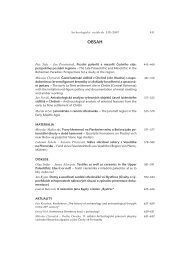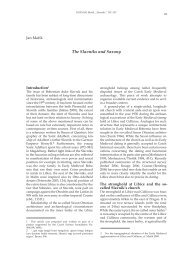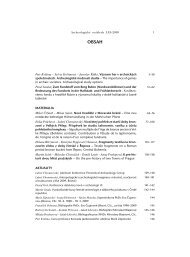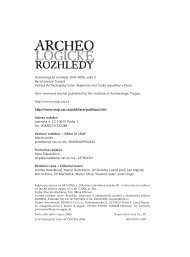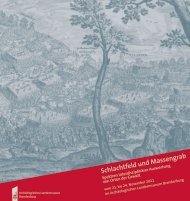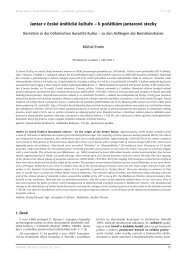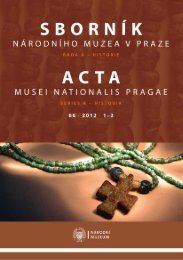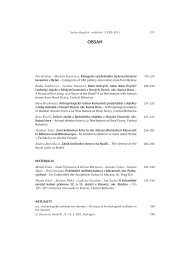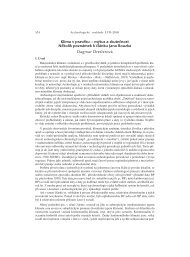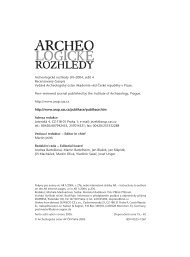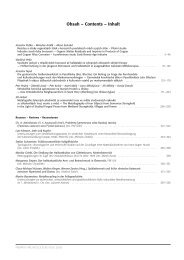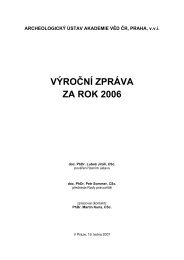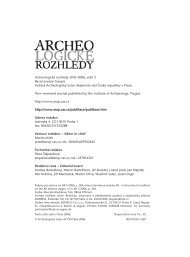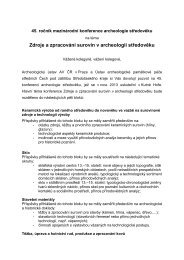2003_2 - Archeologický ústav AV ČR
2003_2 - Archeologický ústav AV ČR
2003_2 - Archeologický ústav AV ČR
Create successful ePaper yourself
Turn your PDF publications into a flip-book with our unique Google optimized e-Paper software.
Archeologické rozhledy LV–<strong>2003</strong> 269or mandible would, from a purely nutritional point of view, be better left in situ and only their meatbrought. This also applies to smaller bones, such as vertebrae, forming an entire backbone in theirfresh state. These bones would then be better classed as mere fuel, or at most building material.In the large accumulation at the Dolní Věstonice I site, the largest number of mammoths is representedby mandibles (48 individuals), followed by atlases (39), ribs and ulnae (38), shoulder–bladesand pelvises (37), molars (18–35) and tusks (34 individuals; Klíma 1969, table 1 – very numerousbones from the 1949–1950 excavations not calculated in). In accumulations 5–8, uncovered by K. Absolondirectly between settlement features, there is a disproportionate preponderance of non–meatybones (shoulder–blades, pelvises, molars) over bones which could have reached the settlement withmeat (vertebrae, ribs, paws; Klíma 2001, 178–179). As area G at Milovice, too, mandibles, shoulder–bladesand pelvises are represented in the greatest numbers (Péan 2001a, fig. 3; 2001b, 181).Skulls would undoubtedly also fall within this group, but given their fragmentary nature are notincluded here. Meaty bones appear only secondarily. At Cracow–Spadzista the greatest number ofindividuals (here about 80) is represented by mandibles, followed by molars, atlases, sesamoids andcaudal vertebrae; fragments of pelvis, shoulder–blade and skull were also numerous, while bonesfrom the limbs – more substantial in terms of sustenance – and the paws are several times rarer.A whole range of similar examples is presented in the text. With the exception of the structuralelements of the dwellings at Milovice G and perhaps at Cracow (mandibles), all of the large bonesmentioned remained in disuse. Thus, they could hardly have been brought to the settlement merelyas fuel (on this, critically Kozłowski 1986, 178), building material or raw material. Tusks, too, appearprofusely at settlements, many of which it has not been possible to withdraw, so that they are absentfrom palaeontological studies. They are common at both settlements with products of mammothivory (Dolní Věstonice I, Předmostí, Pavlov I) and at those where is no trace of mammoth ivoryhaving been worked (Milovice G and northern sectors, Cracow–Spadzista). At several settlementswhere mammoth ivory was worked, a supply of tusks in the stockpiles is missing. The bringingtogether of such an excessive quantity of raw materials and malodorous fuel would be entirely irrational,and has no analogy in either other Palaeolithic or sub–recent hunting cultures. It is also peculiarthat only the bones or horn of the largest animals are involved: prolific use was made of, forexample, reindeer, horse and wolf bones for the manufacture of small tools, and yet stocks of theseare absent. Wolf skeletons are by contrast often undisturbed. Nor is anything known of such massesof bone fuel from among, e.g., the Eskimos or Siberians, from whom above all it might have beenexpected.The remains of large body parts, in which the weight of the bone is greater than the weight ofmeat, formed entire concentrations at Pavlovian settlements. Smaller selections of elephant andmammoth bones, to which the neologism molars is applied, pieces of skull, pelvis, shoulder–bladeetc. have also been recorded at a series of far older sites, e.g. Soleilhac, Venosa – Notarchirico, LaCotte de St. Brelade, Bollschweil, Taubach, Kůlna. At the Romanian Micoquian site of Ripicenitusks appear noticeably often, in several cases arranged into rows and groups, accompanied by concentrationsof chipped stone industry (Paunescu 1993, figs. 38, 52–55). The author interprets theseas the walls of dwellings, of course (Paunescu 1993, fig. 56). As tent poles, however, the heavyand smooth tusks are highly unsuitable – they must be sunk deep enough to avoid being pulledoverbythe weight of the supported roof, and moreover they would lack the gaffs and protuberancesnecessary in order that ropes and horizontal construction elements might be attached to them (thisalso applying to the well–known Châtelperron huts in the cave entrance at Arcy–sur–Cure (Leroi––Gourhan 1961). Within the structure at Ripiceni there is moreover a concentration of mammothmolars, useless in terms of construction. Tusks also dominate the Moustérien site of Molodova Von the Dniestr (Černyš 1961, fig. 8). Reindeer or stag antlers are also related to the stockpiling ofselected faunal remains in the Middle Palaeolithic, these otherwise being unused (Roc–en–Pail andSaint Césaire in France, Plaidter Hummerich and elsewhere in the craters of the Eiffel massif).A similar situation occurs at the beginning of the Upper Palaeolithic. At the South German cave ofGeissenklösterle, which lies in a steep slope m above the valley floor, 3 skulls of young mammoths



